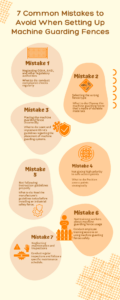American Made, Iron Clad Protected - Discover the Industries Best Warranty.
Blog
7 Common Mistakes to Avoid When Setting Up Machine Guarding Fences
Contact injuries (i.e. amputations, burns, falls, crushes, and avulsions) have become a common phenomenon in various industries. 738 machinery-related fatalities were reported in 2022, according to NIOSH. This insight indicates that numerous workers exposed to machines and equipment are at risk in terms of experiencing life-threatening injuries. That’s why many businesses are actively setting up machine guarding fences in their work sites.
A machine guarding fence acts as a protective shield that safeguards workers from dangerous injuries caused by direct contact with running heavy machinery, conveyor areas, robotic welding areas, and various equipment. It also prevents machinery theft. However, businesses can make mistakes while installing and using a machine guarding fence.
Even the slightest mistake can nullify the purpose of having an industrial safety fence. Improper installation and usage can lead to workers’ injuries, costly OSHA fines, and operational inefficiencies.
In this blog post, we’ll discuss the seven mistakes to avoid while setting up a machine guarding fence. We’ll also suggest ways to avoid those mistakes so you can make the most of your machine guarding fence.
Mistake # 1: Neglecting OSHA, ANSI, and other regulatory authorities
Besides workplace injuries, failing to follow OSHA, ANSI, EN953, and NAAMS standards leads to heavy fines, legal penalties, and even shutdowns. It happens when businesses install a machine guarding fence that isn’t certified by these regulatory authorities. Lack of certification also indicates that such businesses neglect the reachability and height standards. This further makes a machine guarding fence ineffective.
How to avoid this mistake
Before purchasing an industrial safety fence, make sure that it meets OSHA’s, ANSI’s, and other regulatory organizations’ standards for strength, height, and reach. Also, conduct compliance checks regularly to ensure that your machine guarding fence functions accordingly.
Mistake # 2: Selecting the wrong fence type
Every machine guarding fence differs from the other. Selecting the wrong fence type can cause long-term safety hazards. To save industrial costs, some businesses might purchase a machine guarding fence that’s made of low-quality, weak, and affordable materials. Such fencing system can easily break or bend under impact. Its design also blocks visibility (thus, preventing machine operators from safely monitoring the machinery). The lack of modularity also makes future adjustments expensive and difficult.
How to avoid this mistake
While selecting a machine guarding fence, inquire about its materials. Choose the one that’s made of durable materials that also offer longevity (such as mesh made with welded wire). You should also prefer fences that provide high visibility. Such fences are usually made of polycarbonate panels or wire mesh. Fencing systems made of these materials enable machine operators to monitor the machinery safely. An ideal machine guarding fence should also allow easy reconfiguration and expansion as needed.
Mistake # 3: Placing the machine guarding fence incorrectly
A common mistake is to place a machine guarding fence too close to the machinery or moving parts. It increases the risk of serious injury. Another mistake is to install the fence too far as it wastes valuable floor space. This practice can also make maintenance more challenging.
How to avoid this mistake
Learn and implement OSHA’s guidelines regarding the placement of machine guarding systems. Implementing the guidelines during the installation process will help you achieve a safe distance between the machine guarding fence and the machinery. It will also allow easy access for maintenance.
Mistake # 4: Not giving high priority to safe access points
Sometimes, businesses fail to pay attention to access points of a machine guarding fence. When companies install access points that are unsafe, workers can easily bypass the fencing. It can further expose them to hazardous equipment. The lack of lockable gates allows unauthorized access to potentially dangerous machinery.
How to avoid this mistake
Do not place access points in work areas that have high traffic as it could increase the risk of accidents. Instead, position them strategically (in a way that they enable machine operators to carry out maintenance without obstructing the workflow). Besides, you can restrict unauthorized workers from coming nearby the machinery by installing access gates that are lockable.
Another option is to install a machine guarding fence with safety interlocks. These interlocks shut down the equipment or machine when someone opens the gate.
Mistake # 5: Not following instruction guidelines properly
Manufacturer’s instructions for a specific machine guarding fence might differ from the other. That’s why carefully reading the manufacturer’s instructions is a crucial part of the installation process. However, some businesses skip this step as they are either rushing or overcomplicating the installation. Making this mistake can lead to unstable fences. Not properly securing the machine guarding fence to the work area floor can also make it unsafe or wobbly.
How to avoid this mistake
Read the manufacturer’s guidelines twice before installing an industrial safety fence. Also, use the right anchoring methods to make sure that the fence is attached to the floor securely. Once you’ve done the installation, test it to check for any misalignments or weak points.
Mistake # 6: Not training workers about machine guarding fence usage
Even if you’ve installed the best machine guarding fence, it might be ineffective if workers are not using it correctly. Workers might bypass or temper with the fence. They can also be misguided due to a lack of safety labels and clear signage. Untrained workers might also not work well in case of emergency procedures.
How to avoid this mistake
Conduct employee training sessions on using machine guarding fences safely. You can also warn workers to avoid restricted areas by placing signage with high visibility. All workers should also be aware of how to respond in emergency situations regarding the usage of machine guarding fences.
Mistake # 7: Neglecting maintenance and inspections
It’s common for most business owners to assume that machine guarding fences don’t require regular maintenance and upgrades. Once installed, there are hardly any inspections or maintenance procedures. However, lack of maintenance can lean to corrosion, deterioration, and even failure of the fencing system. Not upgrading the fences directly affects their overall functionality.
How to avoid this mistake
Conduct regular inspections and follow a specific maintenance schedule. If you’re unsure if it’s the right time to replace certain components of the machine guarding fence, it’s wise to seek professional help. A professional will inspect and figure out if it’s time to replace the worn-out hinges, panels, or locks. You should also reposition or adjust the fencing in case of deploying additional machinery.
The Takeaway
Proper selection, installation, and maintenance of a machine guarding fence is necessary to achieve workplace safety, operational efficiency, and regulatory compliance. By avoiding the above-mentioned mistakes, it’s possible to provide a safe work environment to facility workers while preventing OSHA fines and costly accidents.
While choosing a machine guarding fence, ensure that the fence doors or panels have hinges. This design allows authorized personnel to get smart access to equipment and machinery. That way, adjustments and inspections also become easier. It’s equally important to choose an industrial safety fence that lasts for years. Whichever machine guarding fence you choose, make sure to conduct routine checkups for regular maintenance.
Recent Posts
- 7 Common Mistakes to Avoid When Setting Up Machine Guarding Fences
- Industrial Curtain Walls: 6 Reasons Why Manufacturing Facilities Must Have Them
- Industrial Soundproof Curtains: How to Decide Between Floor-Mounted and Ceiling-Mounted Curtains
- How to Transform a Noisy Open-Plan Office with Acoustic Baffles
- A Guide to Choosing the Best Concrete Blanket for Construction Projects
- Porch Curtains: 8 Amazing Reasons to Install These Curtains in Your Home
- Chemical Splash Curtains and Their Applications in Different Industries
- Outdoor Sound Curtains for Farms and Animals
- Construction Sound Barriers: Why Every Construction Site Should Have These?
- Industrial Blackout Curtains and Their Applications in Different Settings
Categories
- Accordion Fold Curtains
- Acoustic Baffles
- Agri-Shield Curtains
- Auto Body Shop Curtains
- Bio Plastics
- Industrial Divider Curtains
- Industrial Safety Products
- Insulated Curtain Walls
- Machine Guard Safety Fencing
- Mesh Curtain Screens
- Outdoor Curtains
- PVC Strip Curtains
- Soundproof Noise Blocking Curtains
- Spray Paint Booth Curtains
- Tarps
- Thermal Curtains & Covers
- Uncategorized
- Warehouse Dividers
- Welding Blankets
- Welding Curtains
- Welding Screens




